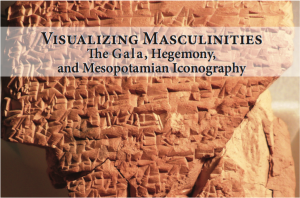
A fragment of the Old Babylonian “Lament for Eridu,” a typical composition that belonged to the corpus of lamentations uttered by the g a l a /kalû. Tablet CBS 2189+2227+2297a, excavated in Nippur (modern Nuffar), currently stored in the Babylonian Section of the University of Pennsylvania Museum of Archaeology and Anthropology. Photograph taken by Ilan Peled. Published with the kind permission of the collection curators, Professors Grant Frame and Steve Tinney.
Near Eastern Archaeology 79:3 article, “Visualizing Masculinities: The Gala, Hegemony, and Mesopotamian Iconography,” by Ilan Peled, Visiting Scholar at the Leiden University Institute for Area Studies.
This article examines the gender image of the Mesopotamian cult attendant known as gala (Sumerian) / kalû (Akkadian) against the background of the theory of hegemonic masculinity, putting an emphasis on visual representations as sources of information. The gala/kalû was a performer in funerals and later a professional lamenter in the cult of Inanna/Ištar. His gender identity has long been considered to have possessed ambiguous elements: effeminate, homoerotic, and the like. A more nuanced approach is offered here, whereby the gala/kalû’s gender image is analyzed as a social construct of a non-hegemonic type of masculinity. To this end, visual representations are considered in addition to textual evidence.